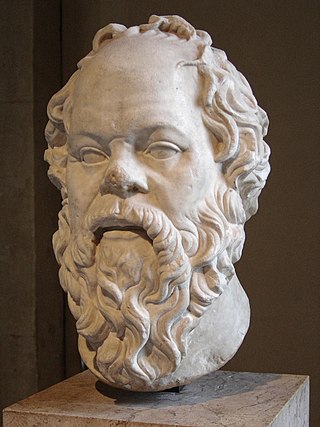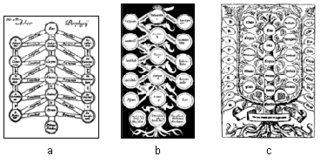
A definition is a statement of the meaning of a term. Definitions can be classified into two large categories: intensional definitions, and extensional definitions. Another important category of definitions is the class of ostensive definitions, which convey the meaning of a term by pointing out examples. A term may have many different senses and multiple meanings, and thus require multiple definitions.
First-order logic—also known as predicate logic, quantificational logic, and first-order predicate calculus—is a collection of formal systems used in mathematics, philosophy, linguistics, and computer science. First-order logic uses quantified variables over non-logical objects, and allows the use of sentences that contain variables, so that rather than propositions such as "Socrates is a man", one can have expressions in the form "there exists x such that x is Socrates and x is a man", where "there exists" is a quantifier, while x is a variable. This distinguishes it from propositional logic, which does not use quantifiers or relations; in this sense, propositional logic is the foundation of first-order logic.
A genus–differentia definition is a type of intensional definition, and it is composed of two parts:
- a genus : An existing definition that serves as a portion of the new definition; all definitions with the same genus are considered members of that genus.
- the differentia: The portion of the definition that is not provided by the genus.

A syllogism is a kind of logical argument that applies deductive reasoning to arrive at a conclusion based on two propositions that are asserted or assumed to be true.

A circular definition is a type of definition that uses the term(s) being defined as part of the description or assumes that the term(s) being described are already known. There are several kinds of circular definition, and several ways of characterising the term: pragmatic, lexicographic and linguistic. Circular definitions are related to Circular reasoning in that they both involve a self-referential approach.
In logic and formal semantics, term logic, also known as traditional logic, syllogistic logic or Aristotelian logic, is a loose name for an approach to formal logic that began with Aristotle and was developed further in ancient history mostly by his followers, the Peripatetics. It was revived after the third century CE by Porphyry's Isagoge.

The is–ought problem, as articulated by the Scottish philosopher and historian David Hume, arises when one makes claims about what ought to be that are based solely on statements about what is. Hume found that there seems to be a significant difference between descriptive or positive statements and prescriptive or normative statements, and that it is not obvious how one can coherently transition from descriptive statements to prescriptive ones. Hume's law or Hume's guillotine is the thesis that an ethical or judgmental conclusion cannot be inferred based on purely descriptive factual statements.
The T-schema is used to check if an inductive definition of truth is valid, which lies at the heart of any realisation of Alfred Tarski's semantic theory of truth. Some authors refer to it as the "Equivalence Schema", a synonym introduced by Michael Dummett.
Predicable is, in scholastic logic, a term applied to a classification of the possible relations in which a predicate may stand to its subject. It is not to be confused with 'praedicamenta', the scholastics' term for Aristotle's ten Categories.
The Topics is the name given to one of Aristotle's six works on logic collectively known as the Organon. In Andronicus of Rhodes' arrangement it is the fifth of these six works.

Haecceity is a term from medieval scholastic philosophy, first coined by followers of Duns Scotus to denote a concept that he seems to have originated: the irreducible determination of a thing that makes it this particular thing. Haecceity is a person's or object's thisness, the individualising difference between the concept "a man" and the concept "Socrates". In modern philosophy of physics, it is sometimes referred to as primitive thisness.

The Porphyrian tree or Tree of Porphyry is a classic device for illustrating a "scale of being", attributed to the 3rd century CE Greek neoplatonist philosopher and logician Porphyry, and revived through the translations of Boethius.
The Sophist is a Platonic dialogue from the philosopher's late period, most likely written in 360 BC. In it the interlocutors, led by Eleatic Stranger employ the method of division in order to classify and define the sophist and describe his essential attributes and differentia vis a vis the philosopher and statesman. Like its sequel, the Statesman, the dialogue is unusual in that Socrates is present but plays only a minor role. Instead, the Eleatic Stranger takes the lead in the discussion. Because Socrates is silent, it is difficult to attribute the views put forward by the Eleatic Stranger to Plato, beyond the difficulty inherent in taking any character to be an author's "mouthpiece".
The term rational animal refers to a classical definition of humanity or human nature, associated with Aristotelianism.
The False Subtlety of the Four Syllogistic Figures Proved is an essay published by Immanuel Kant in 1762.
The Isagoge or "Introduction" to Aristotle's "Categories", written by Porphyry in Greek and translated into Latin by Boethius, was the standard textbook on logic for at least a millennium after his death. It was composed by Porphyry in Sicily during the years 268–270, and sent to Chrysaorium, according to all the ancient commentators Ammonius, Elias, and David. The work includes the highly influential hierarchical classification of genera and species from substance in general down to individuals, known as the Tree of Porphyry, and an introduction which mentions the problem of universals.
In scholastic logic, differentia is one of the predicables; it is that part of a definition which is predicable in a given genus only of the definiendum; or the corresponding "metaphysical part" of the object.
This is an index of Wikipedia articles in philosophy of language

The Definitions is a dictionary of 184 philosophical terms sometimes included in the corpus of Plato's works. Plato is generally not regarded as the editor of all of Definitions. Some ancient scholars attributed Definitions to Speusippus.
In logic, extensional and intensional definitions are two key ways in which the objects, concepts, or referents a term refers to can be defined. They give meaning or denotation to a term.






